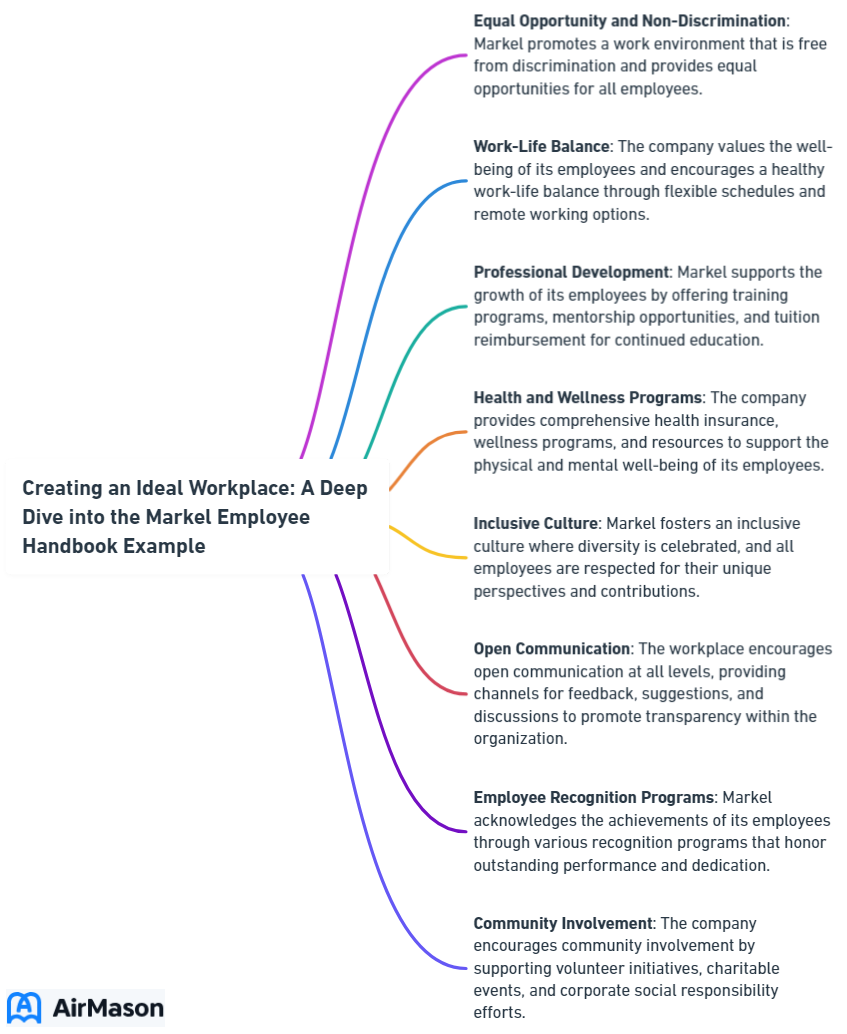
Navigating the creation of an employee handbook can be daunting. The Markel employee handbook example serves as an excellent template for embodying company culture and ensuring legal compliance. This article unpacks Markel’s employee handbook, offering insights on structuring policies and showcasing benefits that resonate with both new and existing staff. Learn how to weave your company’s unique attributes into a handbook that is both effective and legally sound.
Key Takeaways
- The Markel Employee Handbook serves as an exemplary comprehensive guide, addressing company values, policies, procedures, and benefits, while also allowing for flexibility to update contents in alignment with organizational evolution and legal compliance.
- A well-constructed employee handbook should reflect the company culture, outline clear policies and procedures, and detail employee benefits; it plays a vital role in onboarding, professional development, and informing employees about their rights and responsibilities.
- Regular legal review and updating of the employee handbook are critical to ensure it remains current and compliant with changing laws and company policies, thereby effectively mitigating legal risks and maintaining clear communication with employees.
Fortune 500 Companies Employee Handbook
Welcome to the comprehensive Fortune 500 Companies Employee Handbook, your go-to guide for navigating the dynamic landscape of our esteemed organization. Within the pages of this handbook, you will find essential information tailored to ensure a seamless integration into our corporate culture. From company policies and procedures to employee benefits and professional development opportunities, the Fortune 500 Companies Employee Handbook is designed to empower you with the knowledge and resources needed to thrive in your career. As you embark on this exciting journey with us, consider this handbook your compass for success, providing valuable insights and guidelines to enhance your experience within our renowned Fortune 500 company.
The Markel Employee Handbook: An Overview
The Markel Employee Handbook is an excellent example of a well-structured handbook, effectively conveying the company’s values, policies, procedures, and benefits. It serves as a bridge between the company and its employees, ensuring a smooth operational flow and fostering a positive work environment while adhering to employment regulations. Moreover, the transparency and broad applicability of the handbook, accessible even to prospective candidates or customers, highlight the company’s commitment to clear communication and respect for state employment laws.
However, even a comprehensive document like this is not immutable. The company’s values, culture, and market position can evolve over time, and so should the handbook. Companies have the authority to revise or remove any policies, procedures, or statements within the handbook at any time, ensuring it remains relevant and flexible to evolving organizational requirements.
Key Elements of the Handbook
An effective employee handbook goes beyond being a mere list of rules and regulations, instead reflecting the company’s values, vision, and mission. By incorporating these elements into the handbook, employees can align themselves with the company’s direction and assimilate into its culture, which can positively impact customer relationships. Fundamental policies like anti-discrimination, harassment, and leave policies, among others, provide guidance and support for various work aspects while upholding the company’s standards, making it a good employee handbook.
Moreover, a handbook should clearly outline all office addresses, the company’s policy on working from home, and any hybrid work rotations. It should also state the benefits of both working from home and the office, emphasizing that all approaches are deemed acceptable. This transparency and inclusivity can create a sense of security and comfort among employees, enhancing their overall job satisfaction and productivity.
Besides, elements like company values, policies, procedures, and benefits, including retirement plans, are pivotal for employees as they serve as a roadmap for their role within the organization.

Customizing for Your Company
While templates like the Markel Employee Handbook serve as valuable guides, they don’t necessarily cater to all situations. Every company has its unique characteristics, culture, and challenges. Therefore, it’s essential to customize the handbook to fit your organization’s specific needs, including flexible work arrangements. This might involve updating sections and examples, incorporating additional policies and procedures to address industry regulations and company-specific practices, such as handling customer feedback.
However, customization doesn’t mean compromising on compliance. Any alterations to the handbook should pass through the lens of legal counsel to ensure adherence of the company’s policies, procedures, and benefits to prevailing laws and regulations. This due diligence not only safeguards the company and its employees but also makes the handbook a comprehensive document that stands strong in the face of any legal scrutiny.
Crafting a Comprehensive Employee Handbook

Having explored the specifics of the Markel Employee Handbook, it’s time to broaden the scope and delve into the art of crafting a comprehensive employee handbook. This involves a careful orchestration of various elements, ranging from company culture and policies to employee benefits. The handbook should consistently use language that embodies the organization’s spirit, demonstrating the practical application of the company’s ideals and showcasing the behaviors that employees should emulate.
The handbook should encompass a diverse range of policies and procedures, including:
- Onboarding details
- Expectations for code of conduct
- Guidelines for the office environment
- Employment at-will policy
- Principles for equal employment opportunity
- Policies against harassment and discrimination
- Clearly outlined termination processes
To enhance readability and facilitate employees in promptly accessing pertinent information, the handbook should be organized into distinct sections and employ the use of headings, lists, and a table of contents.
Establishing Company Values and Culture
Incorporating company values and culture into an employee handbook is fundamental for fostering a unified and consistent organizational culture. It aids new hires in gaining a deeper understanding of the organization and promotes unity and solidarity among team members. The handbook should articulate the company’s values and mission, underscore their significance in shaping employee conduct, and engage employees in translating these values into actionable steps. This fosters a constructive work culture that is aligned with the company’s vision and mission.
Incorporating the company’s values and culture isn’t just about stating the company’s mission or listing down the values. It’s about showing how these values come to life within the organization, how they guide decision-making, and how they shape the company’s approach to business.
To effectively incorporate company values and culture, consider the following steps:
- Clear outlining of the company’s values and mission, emphasizing their importance
- Reflecting these values in policies and guidelines
- Promoting a respectful and collaborative work environment
- Explaining the ‘why’ behind the values and culture
- Using simple, engaging language
By following these steps, you can create a strong and cohesive company culture that aligns with your values and guides your organization’s actions.
Mohawk Industries Employee Handbook Example
In the Mohawk Industries employee handbook example, employees gain valuable insights into the company’s policies and expectations. This comprehensive guide covers various aspects of the work environment, from professional conduct to benefits and responsibilities. By utilizing the Mohawk Industries employee handbook example, staff members can navigate the intricacies of their roles with clarity and adherence to established guidelines. This document serves as a crucial resource, fostering a cohesive and well-informed workforce. It encapsulates the organizational culture, values, and commitment to creating a positive and productive workplace.
Policies and Procedures
The policies and procedures guiding the company’s day-to-day workings are among the core components of an employee handbook. These serve as the company’s roadmap, guiding employees through the maze of work policies and setting the tone for their interaction within the organization. It’s crucial to include a comprehensive set of policies, such as those addressing bullying, harassment, and leave. When structuring these policies, it’s important to integrate state and local leave laws, specify eligibility criteria and accrual rates, and outline procedures for requesting and approving leave.
Moreover, it’s not just about having the policies in place, but also about making them easily accessible and comprehensible. The handbook should include clear procedures for reporting instances of bullying or harassment, and ensure that there’s a designated individual outside of the employee’s chain of command to receive harassment reports. Similarly, it should also clearly define the types of employment statuses such as full-time, part-time, seasonal, exempt, and nonexempt, providing clarity to employees regarding their roles and the applicable laws and company policies.
Employee Benefits and Perks
Employee benefits and perks carry more weight than just being a side note in an employee handbook. They are a powerful tool to attract, retain, and motivate talent. Including benefits and perks in the handbook can positively impact retention rates by boosting employee satisfaction, showcasing the organization’s commitment to its workforce, and cultivating a conducive workplace environment.
From health insurance and retirement plans to flexible work arrangements and innovative perks like new baby bonuses, fertility assistance, and well-being allowances, the benefits and perks section of the handbook can serve as a significant factor in creating an attractive workplace.
Legal Considerations for Employee Handbooks

While crafting an employee handbook can seem like a straightforward task, it is not devoid of legal implications. From employment status to anti-discrimination policies, there are various legal aspects to consider to ensure that the handbook serves as a comprehensive guide for employees without infringing on any laws. An employment law attorney plays a crucial role in this, evaluating the handbook to guarantee the inclusion of provisions that forbid any type of discrimination, harassment, or reprisal, and providing assistance in formulating comprehensive policies that promote a fair and inclusive work environment.
However, the effort shouldn’t stop at creating the handbook, maintaining it is equally important. Laws and regulations can change over time, and it’s important that the employee handbook keeps up with these changes. Involving legal counsel is of utmost importance when drafting an employee handbook as they can verify compliance with relevant laws and regulations, thereby safeguarding the company from potential legal complications.
Employment Status and At-Will Employment
A vital aspect to consider when crafting an employee handbook is defining employment status clearly and including an at-will employment disclaimer. The ‘At-Will’ Employment Disclaimer is a policy designed to communicate to employees the voluntary nature of their job and the mutual ability of either party to terminate the employment relationship at any time, with or without cause. Providing a clear definition of employment statuses in an employee handbook effectively communicates the rights, benefits, and expectations associated with each status to employees.
It’s not just about stating the employment status or the at-will employment disclaimer, but also about ensuring that these are communicated effectively to the employees. The employee handbook should encompass elements that could justify immediate termination, such as embezzlement, falsification of documents, and gross insubordination.
Additionally, it is crucial for all employees to annually sign the handbook and for the document to be maintained in their personnel file.
Anti-Discrimination and Harassment Policies
Anti-discrimination and harassment policies form the backbone of a fair and inclusive work environment. They serve to safeguard employees by fostering a secure and nurturing work environment devoid of discrimination or mistreatment. Additionally, for the company, the implementation of these policies mitigates legal liabilities and protects the company’s reputation by showcasing a dedication to addressing and preventing such issues.
The handbook should clearly define all forms of discrimination and harassment based on state- and federally-protected categories, such as:
- race
- color
- religion
- sex
- national origin
- disability
- age
- religion
- ethnicity/nationality
- disability/medical history
- marriage/civil partnership
- pregnancy/maternity/paternity
- gender
It’s not just about stating these policies, but also about ensuring that they are accessible to all employees and that there are clear protocols in place for reporting any instances of discrimination or harassment.
Seeking Legal Counsel
When crafting an employee handbook, it’s crucial to not overlook the importance of legal counsel. They can aid in crafting a handbook that adheres to relevant laws and facilitates a clear understanding of rights and responsibilities. An inadequately prepared employee handbook can lead to:
- unintentional imposition of constraints on the at-will employment relationship
- heightened exposure to liability risks
- elevated potential for legal disputes
- ambiguity
- legal accountability
Legal counsel can ensure the employee handbook aligns with all pertinent laws and regulations by conducting regular reviews, documenting all policies, and providing employee training programs. Having a legal professional review the handbook is a critical step for ensuring alignment with legal requirements.
Onboarding and Professional Development

The employee handbook serves not only as a policy document but also as a pivotal tool for the onboarding of new employees and their ongoing professional development. Employee onboarding is a crucial process that involves assimilating new employees into a business. Inadequate onboarding can result in a 64% likelihood of workers leaving their job within the first year. The handbook plays a significant role in the onboarding process by:
- Facilitating smooth onboarding
- Enhancing training experiences
- Fostering effective communication among staff
- Ensuring compliance with local employment standards.
Beyond onboarding, the employee handbook can also support ongoing professional development. It can provide information on training and development opportunities, helping to support employee growth and retention. Training during the onboarding phase is of great importance as it provides new team members with the essential skills and knowledge required to excel in their roles and comprehend the broader operational context of the business.
The Onboarding Process
A well-crafted employee handbook can significantly contribute to the success of the onboarding process. It can serve as a guide for new employees, helping them understand the company’s values, expectations, and culture. During onboarding, regular one-to-one meetings can help monitor progress and ensure that the training plan is running smoothly. These meetings also provide opportunities for new employees to ask questions or raise any concerns, helping to establish positive working relationships..
According to a survey by LinkedIn, the most important aspect of onboarding is obtaining one-to-one time with their line manager. This not only helps to:
- Build a strong rapport between the manager and the new employee
- Provides an avenue for immediate feedback and guidance
- Enhances the overall onboarding experience.
Ongoing Training and Development
Ongoing training and development are crucial to employee growth and retention. The employee handbook should detail a thorough training schedule with topics, timelines, and instructional methods, along with instructions on utilizing essential tools and software. Typical training and development opportunities provided by employers include:
- Onboarding programs
- Technical upskilling
- Professional development
- On-the-job training
- Coaching or mentoring schemes
- Time-management programs
- Leadership programs
- Personal development schemes
However, it’s not just about offering these opportunities, but also about communicating them effectively. Companies can efficiently convey training and development prospects by:
- Clearly articulating the need for training
- Understanding employee goals
- Providing on-the-job learning
- Aligning opportunities with employee aspirations
- Consistently communicating program details
- Recognizing employees who engage in such initiatives.
Maintaining and Updating Your Employee Handbook

An employee handbook isn’t a static document. It should evolve parallel to the company’s growth and evolution. Regularly reviewing and updating the employee handbook is essential to:
- maintaining alignment with current company policies and regulations
- ensuring legal compliance
- providing employees with accurate information about their rights and obligations.
Updating the handbook isn’t merely about introducing new policies or modifying old ones. It’s also about communicating these changes effectively to the employees. In order to effectively communicate updates to an employee handbook, it is crucial to engage in proactive planning, ensure employees are well-informed and involved, and offer training and education regarding the changes.
Regular Reviews and Updates
Regular reviews and updates are crucial to the relevance and effectiveness of an employee handbook. This involves considering several factors, such as:
- Changes in federal, state, and local laws
- Updates in company policies
- Modifications in employee benefits
- Changes in technology and social media use
- Evolving industry standards
It’s recommended for a company to review and update its employee handbook at least annually to ensure its currency and relevance.
Moreover, it’s not just about updating the handbook but also about ensuring that it continues to comply with relevant laws and regulations. This is where legal counsel comes in. They can ensure the employee handbook aligns with all pertinent laws and regulations by conducting regular reviews, documenting all policies, and providing employee training programs.
Expedia Group Employee Handbook Example
Explore the comprehensive guidelines and policies within the Expedia Group employee handbook example, designed to provide clear insights into the company’s values, expectations, and organizational culture. This exemplar document serves as a valuable resource, offering employees a roadmap for navigating their roles and responsibilities within the dynamic environment of Expedia Group. With a focus on transparency and inclusivity, the handbook covers essential topics such as workplace conduct, benefits, and professional development opportunities. As an integral part of the onboarding process, this handbook exemplifies Expedia Group’s commitment to fostering a positive and thriving work environment for its diverse team members.
Communicating Updates to Employees
As important as it is to regularly update the employee handbook, it’s equally important to effectively communicate these updates to employees. This ensures that all employees, regardless of their role or location, are aware of the changes and understand their implications. Here are some tips for effective communication:
- Utilize multiple communication channels
- Deliver clear and concise information
- Incorporate visual aids
- Employ interactive methods to enhance the communication process
By following these tips, you can ensure that your employees are well-informed about any updates to the employee handbook.
Moreover, it’s crucial to ensure that the policies are easily accessible and straightforward to locate. Encouraging feedback and inquiries from employees can also provide valuable insights that can further improve the handbook and its policies. After all, the handbook is meant to serve as a guide for the employees, and their understanding and comfort with its content are paramount to its effectiveness.
Summary
In summary, an effective employee handbook can serve as a valuable tool in fostering a positive workplace culture, ensuring compliance with laws and regulations, and facilitating effective onboarding and continuous professional development. Whether you’re using a template like the Markel Employee Handbook or creating one from scratch, it’s essential to customize the content to fit your organization’s unique needs and culture. Regular reviews and updates, coupled with effective communication of changes, can ensure that your handbook remains relevant and useful, serving as a reliable guide for your employees in their journey with your company.
Frequently Asked Questions
Why is an employee handbook important?
An employee handbook is important because it communicates clear expectations, shapes company culture, and provides a comprehensive guide for employees to understand values, policies, procedures, and benefits. It serves as a crucial tool for effective communication and alignment within the organization.
How often should an employee handbook be updated?
It is recommended to review and update the employee handbook at least annually to ensure it remains current and relevant for employees.
What role does legal counsel play in the creation of an employee handbook?
Legal counsel plays a crucial role in ensuring that an employee handbook aligns with all relevant laws and regulations by conducting regular reviews, documenting policies, and providing employee training programs. This is essential to mitigate legal risks and ensure compliance.
How can an employee handbook support the onboarding process?
An employee handbook can support the onboarding process by providing new employees with a guide to the company’s values, expectations, and culture. It helps them understand what is expected of them from day one.
How can a company effectively communicate updates to the employee handbook?
To effectively communicate updates to the employee handbook, utilize multiple communication channels, deliver clear and concise information, incorporate visual aids, and employ interactive methods. This will ensure that employees are well-informed and engaged with the updates.
Important Disclaimer:
The article presented here does not serve as a representation of the company’s actual employee handbook mentioned in this article.
Our discussions and insights regarding employee handbook are based on assumptions about what may be considered significant in the companies’ policies. These assumptions are drawn from available information and industry knowledge. Readers are advised that the content provided is for informational purposes only and should not be construed as an exact reflection of any company’s official policies or procedures. For precise and accurate details regarding a company’s employee handbook, individuals should refer directly to the company’s official documentation or consult with appropriate representatives.
Please be aware that the content on this page has been generated by using artificial intelligence language models and may contain errors, inconsistencies, or outdated information. It is provided as-is without any warranties or guarantees of accuracy. We strongly recommend using this content as a starting point for further research. We disclaim any liability for damages or losses resulting from the use or reliance on this content.